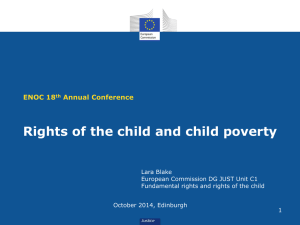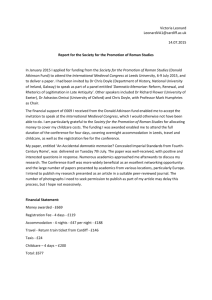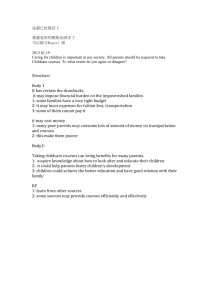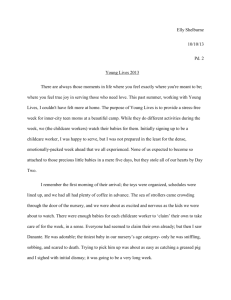D Estimating the potential to increase labour supply
advertisement
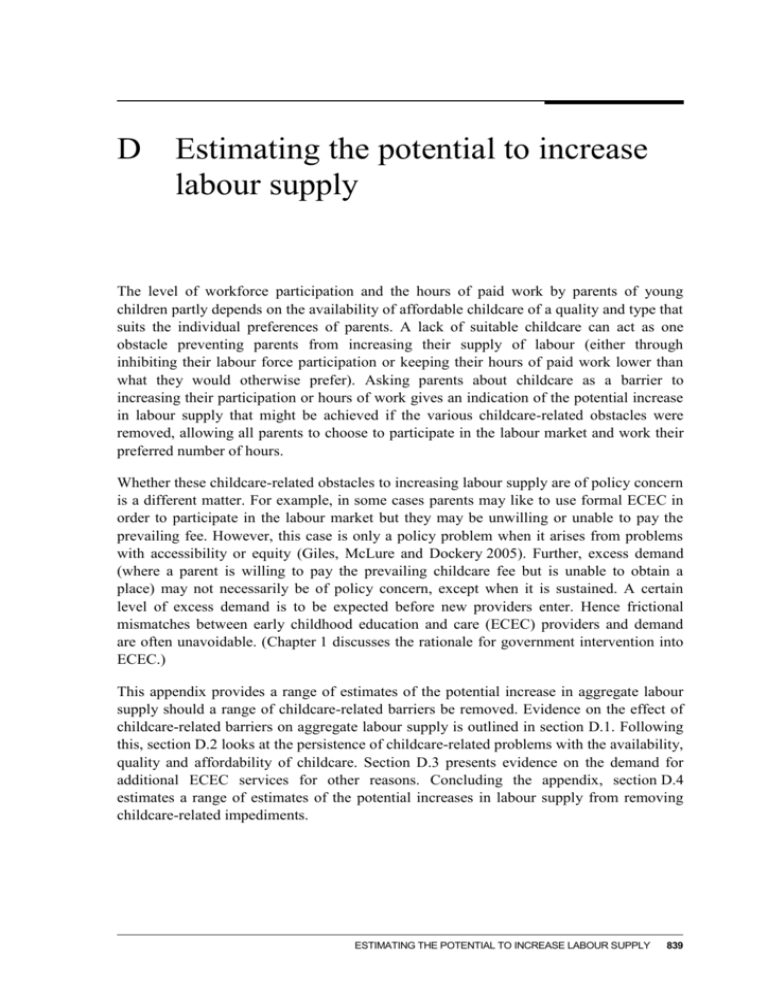
D Estimating the potential to increase labour supply The level of workforce participation and the hours of paid work by parents of young children partly depends on the availability of affordable childcare of a quality and type that suits the individual preferences of parents. A lack of suitable childcare can act as one obstacle preventing parents from increasing their supply of labour (either through inhibiting their labour force participation or keeping their hours of paid work lower than what they would otherwise prefer). Asking parents about childcare as a barrier to increasing their participation or hours of work gives an indication of the potential increase in labour supply that might be achieved if the various childcare-related obstacles were removed, allowing all parents to choose to participate in the labour market and work their preferred number of hours. Whether these childcare-related obstacles to increasing labour supply are of policy concern is a different matter. For example, in some cases parents may like to use formal ECEC in order to participate in the labour market but they may be unwilling or unable to pay the prevailing fee. However, this case is only a policy problem when it arises from problems with accessibility or equity (Giles, McLure and Dockery 2005). Further, excess demand (where a parent is willing to pay the prevailing childcare fee but is unable to obtain a place) may not necessarily be of policy concern, except when it is sustained. A certain level of excess demand is to be expected before new providers enter. Hence frictional mismatches between early childhood education and care (ECEC) providers and demand are often unavoidable. (Chapter 1 discusses the rationale for government intervention into ECEC.) This appendix provides a range of estimates of the potential increase in aggregate labour supply should a range of childcare-related barriers be removed. Evidence on the effect of childcare-related barriers on aggregate labour supply is outlined in section D.1. Following this, section D.2 looks at the persistence of childcare-related problems with the availability, quality and affordability of childcare. Section D.3 presents evidence on the demand for additional ECEC services for other reasons. Concluding the appendix, section D.4 estimates a range of estimates of the potential increases in labour supply from removing childcare-related impediments. ESTIMATING THE POTENTIAL TO INCREASE LABOUR SUPPLY 839 D.1 The effect of childcare-related barriers on labour supply The Australian Bureau of Statistics (ABS) Survey of Income and Housing (SIH)1 collects biennial information on the potential labour supply of parents (and guardians) of children aged 0 to 12 years facing difficulty with childcare. The survey asks whether: parents working part time were prevented from working longer hours by lack of childcare unemployed parents considered a lack of childcare is an impediment to finding a suitable job parents not working would (or may) prefer to work if suitable childcare was available. Parents who were usually in the full time paid workforce were assumed to have no capacity to increase their hours of paid work and consequently the SIH did not ask full time workers any questions about a lack of childcare as an impediment to their labour supply. Excluding full time workers from questions on potential labour supply is consistent with the framework used by the ABS for underemployed workers (ABS 2014c). Parents who reported a lack of childcare as an obstacle were also asked about the reasons childcare prevented them from working or working longer hours as well as the number of hours per week they would prefer to work if suitable childcare was available. There were around 18 000 and 14 600 fully responding households to the 2009-10 and 2011-12 SIH, respectively. Some parents want paid work or to work longer hours but are prevented because of a lack of childcare An estimated 444 000 parents with a child aged 0 to 12 years old indicated they were prevented from entering the labour force or working longer hours by a lack of childcare in 2011-12 (table D.1). Around two thirds of these parents were not in the paid workforce (that is, they included those that were either unemployed or out of the labour force). A similar pattern was observed in 2009-10. 1 The SIH is conducted biennially, and from 2007-08 has collected data on the usage and cost of childcare as well as barriers to labour force participation due to childcare-related reasons. The SIH covers urban and rural areas (excluding very remote areas) of Australia covering about 97 per cent of the population (ABS 2013b). The ABS (2013b) noted that while excluding very remote areas only has a minor impact on aggregate estimates, nearly a quarter of all households in the Northern Territory live in very remote areas. 840 CHILDCARE AND EARLY CHILDHOOD LEARNING More than 9 out of 10 parents who indicated they were prevented from either working or working longer hours due to a lack of childcare were women. (This ratio was even higher for parents not in the labour force.) The high ratio of women who indicated a lack of childcare as a barrier to increasing their labour supply is likely to reflect that mothers, more often than fathers, take time out of the workforce to care for children. In 2011-12, childcare-related barriers affected almost one quarter (24 per cent) of parents not working or working part time. Table D.1 Lack of childcare as a barrier to increased labour supply Parents with children aged 0 to 12 years who were not working or were working part time Not workinga Part time Totalb 297 000 147 000 444 000 [401 000, 487 000] 33 16 24 2009-10: Estimated number of parents who indicated a lack of childcare as a barrier to increasing labour supplyc 286 000 118 000 404 000 [363 000, 443 000] Percentage of parents who indicated a lack of childcare as a barrier to increasing labour supply (%) 31 13 23 2011-12: Estimated number of parents who indicated a lack of childcare as a barrier to increasing labour supplyc Percentage of parents who indicated a lack of childcare as a barrier to increasing labour supply (%) a Parents not working includes parents not in the labour force and unemployed parents. The two categories were grouped together because of the low number of unemployed parents and the resulting high standard errors of estimates. b While a smaller number of parents with a child under 13 years old reported lack of childcare as a barrier in 2009-10 compared with 2011-12, this difference is not statistically significant. c The 95 per cent confidence interval is in brackets. This indicates that if the survey methodology was repeated 100 times, the actual value of the variable in the general population would be expected to fall within the calculated confidence interval 95 times. Source: Productivity Commission estimates based on ABS (2013c, 2014b). Childcare and work decisions are usually jointly determined by families and are influenced by many factors including: parents’ preferences for formal, informal and parental care; parents’ employment opportunities; the availability and quality of ECEC; childcare fees; travel costs; and family characteristics such as income, the number of and age of children (Gray and Hayes 2008). The outcome of these joint family decisions — the type of work, the number of hours worked and the number of hours and type of ECEC used — will vary between families and over time. If parents who report a lack of childcare as an ‘obstacle’ to participating in the labour force (or to working more hours) are concentrated within families with particular characteristics this may suggest issues with accessibility and equity. For this reason, it is useful to examine the characteristics of the estimated 444 000 parents who indicated a lack of ESTIMATING THE POTENTIAL TO INCREASE LABOUR SUPPLY 841 childcare as a barrier to increasing their labour supply and the nature of (reasons driving) this obstacle. Lack of childcare as a barrier to increasing labour supply is more prevalent for parents with relatively low economic resources Demand for ECEC services can be studied using household income as a very broad indicator of the level of economic resources available to parents.2 Parents can be divided into income groups by ranking all households in ascending order on the basis of gross household income (ABS 2013a). Low income households have a gross household income in the bottom 30 per cent of households. (This equated to $850 or less per week in 2011-12 and $813 or less per week in 2009-10.)3 High income households have income ranking in the top 20 per cent of households. (This equated to $2231 or more per week in 2011-12 and $2118 or more per week in 2009-10.) Middle income households makeup the remaining households. While around 30 per cent of parents in low income households reported a lack of suitable childcare as a barrier to increasing their labour supply, less than 20 per cent of parents in high income households reported this problem (figure D.1). There appeared to be an increase in the share of parents in middle and high income households who reported this obstacle between 2009-10 and 2011-12, however the estimates were not statistically different. As may be expected, a relatively large proportion (27 per cent) of parents who indicated they were unable to find suitable childcare to enable them to participate in the workforce lived in low income households. In contrast, less than 10 per cent of parents who reported this barrier (but who were working part time) lived in low income households (figure D.2). 2 Economic resources are also dependent on household wealth (assets and liabilities), which can allow households to borrow money and, therefore, can generate household income. 3 The ABS usually defines low income households to be those households in the second and third income deciles: ‘… households in the bottom income decile and with negative gross incomes tend to have expenditure levels that are comparable to those of households with higher income levels … It can therefore be reasonably concluded that many of the households included in the lowest income decile are unlikely to be suffering extremely low levels of economic wellbeing’ (ABS 2013a, p. 50). 842 CHILDCARE AND EARLY CHILDHOOD LEARNING Figure D.1 Parents who indicated lack of childcare was a barrier to increasing their labour supply by household income group Per cent of parents with children aged 0 to 12 years who were not working or were working part time 35 30 Per cent 25 2009-10 20 2011-12 15 10 5 0 Low income households Middle income households High income households Source: Productivity Commission estimates based on ABS (2013c, 2014b). Figure D.2 Parents who indicated lack of childcare was a barrier to increasing their labour supply by labour force status and household income group Parents with children aged 0 to 12 years who were not working or were working part time, 2011-12 Not working Middle 56% Working part time High 17% Middle 55% High 37% Low 27% Low 8% Source: Productivity Commission estimates based on ABS (2013c). ESTIMATING THE POTENTIAL TO INCREASE LABOUR SUPPLY 843 Alongside parents not working and those in low income households, reporting that a lack of childcare was a barrier to increasing labour supply was also more prevalent for single parents (figure D.3). There is also an association between family type and household income. For example, in 2011-12, persons in ‘one parent families with dependent children’ accounted for 7 per cent of all persons but they comprised 18 per cent of persons in ‘low economic resource households’ (ABS 2013a). Parents and children living in low economic resource households are of policy interest because of their greater risk of experiencing economic hardship and reliance on social security. Of particular policy concern are the 76 000 single parents who would like to work (or to work longer hours) but who indicated they were prevented from doing so due to a lack of access to childcare in 2011-12. (Further, over 60 per cent were in low income households.) Figure D.3 Lack of access to childcare as a barrier to increasing labour supply is more prevalent for single parentsa Parents with children 0 to 12 years who were not working or are working part time, 2011-12 100 Per cent 80 No unmet demand 60 Unmet demand 40 44 20 15 22 31 0 Partnered Single parents, parents, working working part time part time Partnered parents, not working Single parents, not working a Partnered parents include parents in a registered marriage or a de facto relationship. Source: Productivity Commission estimates based on ABS (2013c). 844 CHILDCARE AND EARLY CHILDHOOD LEARNING Demand for childcare changes as children age Parents’ ability to access and afford ECEC services will depend, among other things, on the number of hours of care required, out-of-pocket costs (related to the age of the child) and employment opportunities. Parents — and single parents in particular — with children not yet at school more frequently reported that a lack of childcare was a barrier to increasing their labour supply when compared with parents of older children (figure D.4). The affordability of childcare was the most commonly reported barrier to workforce participation for parents with children under 5 years old. Half of all parents who indicated that a lack of access to childcare was an obstacle to increasing their labour supply and whose youngest child is aged 3 to 4 years, reported the out-of-pocket cost of care was the main childcare-related barrier (figure D.7). As children grow older and enter formal schooling, the number of hours of ECEC required in order for parents to participate in the workforce (at least on a part-time basis) declines. Figure D.4 shows that a smaller proportion of parents whose youngest child was aged 5 to 12 years reported lack of ECEC services as an obstacle relative to parents whose youngest child was under 5 years of age. The availability and flexibility of childcare as the main childcare-related barrier to increased labour supply was slightly more common for parents with all children at school relative to parents with younger children (figure D.7). The data from the SIH showed that the prevalence of childcare-related barriers to increasing labour supply also increases as the number of children in the household under 15 years increases. For parents working part time or not working, the proportion of parents reporting a lack of childcare as a barrier to increasing labour supply increased from 21 per cent of parents with one child to 26 per cent of parents with three or more children (figure D.4). The prevalence of this barrier was highest for single parents with three or more children — over 40 per cent in 2011-12.4 4 This estimate should be treated as indicative only due to the low number of observations for this category and the resulting high relative standard error (18 per cent). ESTIMATING THE POTENTIAL TO INCREASE LABOUR SUPPLY 845 Figure D.4 Parents who indicated a lack of access to childcare as a barrier to increasing their labour supply by age of youngest child and number children Parents with children 0 to 12 years who were not working or were working part time, 2011-12 Age of youngest child 50 Partnered 40 Single Per cent Total 30 20 10 0 2 years or younger 3 to 4 years 5 to 12 years Number of children under 15 years old 50 Partnered 40 Single Total Per cent 30 20 10 0 1 child 2 children Source: Productivity Commission estimates based on ABS (2013c). 846 CHILDCARE AND EARLY CHILDHOOD LEARNING 3 or more The proportion of parents who reported a lack of access to childcare as an obstacle to increasing their labour supply and who were working part time, increases as the age of the youngest child increases — from 24 per cent of parents with a child 2 years old or younger to 45 per cent of those with school-aged children (figure D.5). This implies that there may be scope to increase the number of paid hours of work for parents of school-aged children (5 to 12 years old) who are working part time. Even so, the number of parents who reported a childcare-related barrier to increasing their labour supply and who were not working far outstripped the comparable number who were working on a part time basis. Figure D.5 Parents who indicated a lack of access to childcare as a barrier to increasing their labour supply by age of youngest child and labour force status Parents with children 0 to 12 years, 2011-12 100% 80% 81,000 58,000 60% 158,000 Not working Part time 40% 66,000 20% 30,000 51,000 0% 2 years old or younger 3 to 4 years old 5 to 12 years old Source: Productivity Commission estimates based on ABS (2013c). Why is it that some parents could not find ECEC services to match their employment and family circumstances? Examining the main reasons why a lack of childcare was a barrier to participation showed two strong themes. First, their out-of-pocket childcare costs prevented many parents who wished to increase their labour supply from doing so. Affordability of childcare was the main barrier to participating (or working longer hours) for nearly half of all part-time workers who reported lack of childcare was an obstacle (figure D.6). ESTIMATING THE POTENTIAL TO INCREASE LABOUR SUPPLY 847 Second, many parents preferred to look after their own children or felt that their child was too young (or old) to be in childcare. For example, 38 per cent of parents who reported a lack of childcare was an obstacle to participating or working longer hours had a preference to care for their own child(ren). Notably, a higher proportion of parents in this category who were not working reported a preference to care for their own child (42 per cent) compared to those working part time (31 per cent). Those parents who were not in the paid workforce may have felt that the range of ECEC services available to them were not highly substitutable with caring for their children themselves. Figure D.6 Main reason that a lack of childcare prevented parents from increasing their labour supply by labour force status Per cent of parents with children aged 0 to 12 years who indicated a lack of access to childcare as a barrier to increasing their labour supply, 2011-12 Prefer to look after own child or child too young/old Cost/too expensive Availability(a) Total Not working Flexibility Part time Child has special needs Other 0 10 20 30 40 50 a Availability includes: booked out/no places; and time/days available not suitable. Flexibility where parents indicated that the main reason was childcare being not flexible enough/not available at short notice. Other includes: transport/distance; child’s preference; and other childcare reason. Source: Productivity Commission estimates based on ABS (2013c). The remaining 26 per cent of parents expressed a range of issues surrounding their access to ECEC services — booked out or no places or times/days not suitable; not flexible enough or not available at short notice; transport or distance; or that the child has special needs or other childcare reasons (figure D.6). These issues may, in part, have reflected the difficulties faced by some casual and shift workers with relative inflexibility of most ECEC services. The availability and flexibility of ECEC services also appeared to be more of an issue for single parents compared with partnered parents, with proportionately more single parents 848 CHILDCARE AND EARLY CHILDHOOD LEARNING reporting these reasons as the main barrier to them finding suitable childcare in order to participate (or work long hours) in the paid workforce (figure D.7). A small proportion (5 per cent) of parents (indicatively representing 21 000 parents) reported they were unable to find suitable childcare to increase their labour supply because their ‘child has special needs’ (figure D.6).5 The share of these parents increases with the age of the youngest child, from 1 per cent of parents whose youngest child is aged two years or younger to roughly 9 per cent of parents whose youngest child is at school (figure D.7). Chapter 13 notes that lower rates of disability are reported for children under five years old compared to older children partly because it takes time for conditions to be identified and for children to have the ability to sit and concentrate for some assessments, and partly because some disabilities are acquired during childhood and beyond. This may explain the relatively low number of parents with a very young child (two years or under) who reported a lack of access to childcare as an obstacle to increasing their labour supply because their child has special needs. Considering the group of parents with childcare-related obstacles to increasing labour supply due to accessibility reasons,6 the overall number of parents reporting such barriers was estimated to be 3 per cent (or 30 000) of all parents working part time, and around 8 per cent (or 84 000) of all parents not working in 2011-12. How many hours would parents like to work? On average, in 2011-12 those parents who reported a childcare-related barrier and who were not working indicated that they would have liked to work 25 hours per week if suitable childcare was available (table D.2). By comparison, their counterparts who were working part time indicated they would have preferred to work an additional 13 hours per week. The average number of preferred hours was only slightly higher for families with the youngest children attending formal schooling on a full time basis. Most parents who reported a childcare-related obstacle to increasing their labour supply preferred to work part time (Figure D.8). (A similar distribution of preferred additional hours was found in 2009-10.) Examining the total number of hours part time workers would like to work — the number of hours worked in all jobs plus the additional hours they would like to work if suitable childcare was available — indicated that while the majority of parents working part time would prefer to remain working part time, 37 per cent preferred to work full time. 5 These estimates have high standard errors and should be used with caution. 6 Accessibility reasons include: booked out or no places or times/days not suitable; not flexible enough or not available at short notice; transport or distance; or that the child has special needs or other childcare reasons. ESTIMATING THE POTENTIAL TO INCREASE LABOUR SUPPLY 849 Figure D.7 Main reason that a lack of access to childcare prevents increasing the labour supply of parents by selected family characteristics Per cent of parents with children aged 0 to 12 years who reported lack of access to childcare was a barrier to increasing their labour supply, 2011-12 Single and partnered parents Prefer to look after own child or child too young/old Cost/too expensive Availability(a) Single Partnered Flexibility Child has special needs Other 0 10 20 30 40 50 Age of youngest child Prefer to look after own child or child too young/old Cost/too expensive Availability(a) 2yr or younger 3 to 4 years Flexibility 5 to 12 years Child has special needs Other 0 10 20 30 40 50 a Availability includes: booked out/no places; and time/days available not suitable. Flexibility where parents indicated that the main reason was childcare being not flexible enough/not available at short notice. Other includes: transport/distance; child’s preference; and other childcare reason. Source: Productivity Commission estimates based on ABS (2013c). 850 CHILDCARE AND EARLY CHILDHOOD LEARNING Table D.2 Preferred number of hours per week among parents who would like to work (or work longer hours) if suitable childcare was available By labour force status for parents with children aged 0 to 12 years Working part time Not working 12 13 13 24 24 26 21 20 20 13 25 21 1 849 000 [1 529 000, 2 168 000] 7 315 000 [6 301 000, 8 330 000] 9 164 000 [8 098 000, 10 200 000] 40 000 193 000 242 000 11 16 14 23 25 23 21 23 19 13 23 20 1 580 000 [1 257 000, 1 903 000] 6 666 000 [5 943 000, 7 389 000] 8 246 000 [7 302 000, 9 189 000] 42 000 175 000 217 000 Total 2011-12: Mean preferred (additional) hours: If youngest child is 2 years or younger If youngest child is 3 to 4 years old If youngest child is 5 to 12 years old All parents who indicated a lack of access to childcare as a barrier to increasing their labour supply Total preferred (additional) number of hours per week if their childcare-related barrier(s) to increasing their labour supply for childcare was removeda FTE number of workersb 2009-10: Mean preferred (additional) hours: If youngest child is 2 years or younger If youngest child is 3 to 4 years old If youngest child is 5 to 12 years old All parents who indicated a lack of access to childcare as a barrier to increasing their labour supply Total preferred (additional) number of hours per week if all childcare-related barriers to increasing their labour supply were removeda FTE number of workersb a 95 per cent confidence intervals are in parentheses. b Full-time equivalent (FTE), based on a 38 hour work week. Source: Productivity Commission estimates based on ABS (2013c, 2014b). ESTIMATING THE POTENTIAL TO INCREASE LABOUR SUPPLY 851 Figure D.8 Distribution of preferred number of hours per week among parents who would like to work (or work longer hours) if suitable childcare was available Parents with children aged 0 to 12 years, 2011-12 Additional hours per week 60 50 Per cent 40 30 20 10 0 1 to 9 hours 10 to 19 hours Currently part time 20 to 34 hours Currently not working 35 or more hours Total Total preferred hours per week – for parents currently working part timea 60 Per cent 50 40 30 20 10 0 1 to 9 hours 10 to 19 hours 20 to 34 hours 35 or more hours a Total number of hours part time workers would like to work is estimated as the number of hours usually worked per week (in main and second job) plus the additional hours they would like to work. Source: Productivity Commission estimates based on ABS (2013c). 852 CHILDCARE AND EARLY CHILDHOOD LEARNING The potential to increase labour supply — some estimates If suitable childcare were to became available and it facilitated all those parents to work their preferred number of hours, in 2011-12 an estimated 242 000 full time equivalent (FTE) workers potentially could have been added to the workforce (table D.2).7 This would have represented an increase in total hours worked of around two per cent in 2011-12 (ABS 2012). (The estimated number of FTE workers was 217 000 in 2009-10, but was not statistically different from the 2011-12 estimate.) These ‘additional’ workers are predominately made up of mothers who are marginally attached to the labour force. That is, they are not currently working or actively looking for work but would like to enter the workforce if suitable childcare became available. Arguably, the 38 per cent of parents in 2011-12 who reported the main reason that a lack of childcare prevented them from working reflected their preference to care for their own child(ren) at home (or that their child is too young/old) may have great difficulty finding childcare to suit their preferences. Excluding these parents reduces the estimated number of FTE workers potentially added to the labour supply to around 156 000 FTE workers (table D.3). This potential increase in the labour supply could be constrained further to look exclusively at meeting the demand for the 26 per cent of parents whose main difficulty is accessing ECEC services — which comprised parents reporting difficulties due to the availability or flexibility of ECEC services, with transport or distance to services, or that their child has special needs. For this group, the estimated number of FTE workers potentially added to the aggregate supply of labour would have been around 72 000 in 2011-12 (table D.3). Using a more recent estimate of the number of parents working part time or not working (ABS 2014a) and assuming that the share of parents with childcare-related obstacles is unchanged,8 an estimated 165 000 FTE workers could have potentially been added to the supply of labour in July 2014 if childcare-related barriers were removed for those parents reporting to have difficulties with the affordability and accessibility of suitable childcare. 7 The FTE number of additional workers was derived by dividing the total number of additional hours among those parents who reported childcare-related barriers who would prefer to work, by 38 hour per week. 8 In the 2011-12 SIH, the 156 000 FTE number of additional workers accounted for 7.5 per cent of all parents with a child(ren) under 15 years old and working part time or not working. ESTIMATING THE POTENTIAL TO INCREASE LABOUR SUPPLY 853 Table D.3 Potential workforce participation if the childcare-related barrier to increasing labour supply were removed for certain parents By labour force status for parents with children aged 0 to 12 years Working part time Not working 1 311 000 4 599 000 5 910 000 35 000 121 000 156 000 413 000 2334000 2 747 000 11 000 61 000 72 000 879 000 3 718 000 4 597 000 23 000 98 000 121 000 277 000 1 326 000 1 603 000 7 000 35 000 42 000 Total 2011-12: Parents who reported affordability or accessibility barriers a Total preferred (additional) number of hours per week FTE number of workers b Parents who reported accessibility barrier only Total preferred (additional) number of hours per week FTE number of workers b 2009-10: Parents who reported affordability or accessibility barriers a Total preferred (additional) number of hours per week FTE number of workers b Parents who reported accessibility barrier only Total preferred (additional) number of hours per week FTE number of workers b a Excludes parents who state the main reason that childcare prevents them from working/working more is that they ‘prefer to look after own child’ or ‘child is too young/old’. b Full-time equivalent (FTE), based on a 38 hour work week. Source: Productivity Commission estimates based on ABS (2013c, 2014b) D.2 The persistence of problems with the availability, quality and affordability of childcare Given the complex nature of the demand for and supply of ECEC services, some difficulty with finding childcare to match individual preferences and circumstances is to be expected. However, the extent to which parents experience ongoing challenges accessing suitable childcare and engaging with the labour force is of policy concern. Some evidence of ongoing or persistent problems in obtaining childcare is available from the Household, Income and Labour Dynamics in Australia (HILDA) Survey. In that (longitudinal) survey, households with children under 15 years old who used, or thought about using, childcare so either partner could undertake paid work in the year prior to the survey were asked to indicate the level of difficulty experienced with childcare. Their 854 CHILDCARE AND EARLY CHILDHOOD LEARNING responses were recorded on a scale of 0 to 10 — with 0 being ‘not a problem at all’ and 10 being ‘very much a problem’.9 In particular, the HILDA Survey asks about a broad range of potential difficulties that households may face with the availability of childcare, namely: finding a place at the childcare centre of choice finding care during the school holidays finding care for a difficult or special needs child getting care for the hours needed finding a child care centre in the right location finding care for a sick child finding care at short notice juggling multiple child care arrangements. In the following analysis, parents who scored 5 or more out of 10 on one or more of the above areas were classified as having experienced difficulty with the availability of ECEC. (The Melbourne Institute of Applied Economic and Social Research (2014) also used a score of five or higher to define whether or not a household experienced difficulty with a particular aspect of childcare.) Parents were classified as having experienced difficulty with the quality of childcare if they reported a level of difficulty of 5 or more out of 10 with: finding good quality childcare finding the right person to take care of my child finding care my children are happy with. Similarly, parents in households rating the difficulty with ‘the cost of childcare’ with a score of 5 or more were classified as having difficulty with affordability. Parents could simultaneously report difficulties with multiple aspects of childcare — availability, quality and cost. Further, the aspects of ECEC that parents reported difficulty with may change from year to year. In the following discussion, the category any difficulty counts the total number of parents reporting a difficulty, irrespective of the type or number of categories of childcare they reported the difficulty with. The analysis tracks partnered mothers and single parents for the three most recent years of the HILDA Survey — that is, parents who had responded to the HILDA Survey in 2010, 2011 and 2012. The analysis is limited to partnered mothers and single parents who had a child aged 12 years or under living in the household in 2010. As the workforce status of 9 In the HILDA Survey parents who did not use, or think about using, childcare to undertake paid work over the past 12 months were not asked about any difficulty they experienced with childcare. ESTIMATING THE POTENTIAL TO INCREASE LABOUR SUPPLY 855 mothers is more commonly associated with childcare use (relative to fathers in couple families), the analysis focuses on partnered mothers. A similar approach was adopted by McNamara et al. (2005) in their examination of the persistence of problems with childcare (using wave 2 and 3 of the HILDA Survey) which focused on mothers. Further, parents in multi-family households have been excluded from the analysis. This exclusion is unlikely to make a substantial difference to the analysis, as partnered mothers and single parents living in multi-family households only account for a small percentage (around 3 per cent when weighted) of all partnered mothers and single parents. Some parents experienced persistent difficulties with the availability, quality or affordability of childcare Roughly half of the mothers and single parents responding to the HILDA Survey in 2010 did not use or think about using childcare so that they or their partner could undertake paid work. (These parents were not asked any questions about difficulty with childcare.) Of the remaining parent mothers and single parents, 68 per cent reported experiencing difficulty with the availability, quality and/or affordability of childcare . For partnered mothers and single parents who reported difficulty with childcare in 2010, figure D.9 tracks the persistence of different aspects of reported difficulties with childcare between 2010 and 2012. For example, of the partnered mothers and single parents who used or thought about using childcare in 2010: 68 per cent reported difficulty with one or more aspects (ie any difficulty) in 2010 45 per cent reported difficulties in 2010 and 2011 32 per cent reported persistent problems with one or more aspects for the three years from 2010 to 2012. If the population of parents is expanded to include parents who did not use or think about using childcare to undertake paid work in 2010, then 22 per cent of all partnered mothers and single parents reported persistent difficulty with one or more aspect of childcare for the two years to 2012; and 16 per cent for the three years to 2012. The availability of childcare was the most common and the most persistent childcare difficulty nominated by parents. Difficulties with the quality of childcare were not as common and less persistent compared with the availability and affordability of care (figure D.9). 856 CHILDCARE AND EARLY CHILDHOOD LEARNING Figure D.9 Persistence of difficulties with availability, quality and affordability of childcare Per cent of partnered mothers and single parents with children aged 0 to 12 years who used or thought about using childcare to undertake paid work in 2010 80 60 40 20 0 Availability Quality 2010 In 2010 & 2011 Affordability Any difficulty In 2010, 2011 & 2012 Source: Productivity Commission estimates based on HILDA Survey release 12, waves 10–12. Does labour force status influence reported difficulties with childcare? But what does difficulty (and persistent difficulty) with childcare actually measure? Broadly, parents reporting difficulty with childcare will either be: accessing ECEC services but may be dissatisfied with current centre/program or type of care and may wish to change ECEC location or type not accessing (enough) ECEC to be able to work the desired number of hours they would like to work. It is this second group of parents for whom difficulty with availability, quality and affordability of childcare may be preventing them from participating in the labour force or from working their preferred number of hours. In this context, it is useful to consider the different reported difficulties with childcare and the labour force status of parents. ESTIMATING THE POTENTIAL TO INCREASE LABOUR SUPPLY 857 Parents working full time are more likely to report persistent difficulties with childcare affordability Difficulties with childcare reported by mothers and single parents working full time is likely to be due to not being able to access ECEC services that meet their preferences (rather than not being able to access some formal or informal ECEC at all). The over-representation of parents working full time in the group reporting persistent difficulty between 2010 and 2012 (figure D.10) may reflect difficulties with the out-of-pocket cost of care that parents face once reaching the $7500 cap on the Child Care Rebate. Figure D.10 Labour force composition of partnered mothers and single parentsa Partnered mothers and single parents with children aged 0 to 12 years Population of all partnered mothers and single parents Not working 37% Full time 25% Part time 38% Parents who reported persistent difficulty with childcare to undertake paid work from 2010 to 2012 Not working 16% Full time 34% Part time 50% a Based on parents’ labour force status in 2010. Source: Productivity Commission estimates based on HILDA release 12, waves 10–12. Broadly, parents working full time do not have capacity to increase their labour supply. What’s more, nearly all (92 per cent) of partnered mothers reporting difficulty with childcare while working full time also had a partner working full time in 2010. While parents working full time may not be able to (substantially) increase their hours of paid work, it may be that those parents who reported difficulty with childcare in one period will reduce the hours they work or withdraw from the labour force in a later period. 858 CHILDCARE AND EARLY CHILDHOOD LEARNING Around one third of all partnered mothers and single parents working full time who used or thought about using childcare in 2010 experienced persistent difficulties with one or more aspects of childcare between 2010 and 2012 (figure D.11). Of those parents who persistently reported difficulties with care, a relatively high share of full time workers had persistent difficulties with the affordability of childcare — 21 per cent of full time workers who used or thought about using childcare in 2010 reported difficulties with the affordability of care between 2010 to 2012, compared to less than 18 per cent of parents working part time or not working (figure D.11). Parents working part time had persistent difficulties with the availability of childcare There is potentially scope to increase the labour supply of parents who report difficulty with childcare and work part time. Part-time workers accounted for 38 per cent of all partnered mothers and single parents in 2010 and half of the group reported persistent difficulties lasting two or more years (figure D.10). Just over one third of partnered mothers and single parents working part time in 2010 who used or thought about using childcare reported difficulties with childcare on an ongoing basis between 2010 and 2012 (figure D.11). Looking at the second panel in figure D.11, of those parents with persistent difficulties with childcare, part-time workers in particular had persistent difficulty with ECEC availability. Parents not working also experienced persistent difficulties with the availability and affordability of childcare There is also scope to increase the labour supply of parents who are not working and who report a difficulty with childcare. Parents not working (in the base year 2010) were less likely to use or think about using childcare to undertake paid work and, therefore, accounted for a disproportionally small proportion of parents who experienced difficulties with childcare in 2010. However, of those parents not working who did think about using childcare to undertake paid work in 2010, 70 per cent reported having difficulties (figure D.11). The availability and affordability of childcare was also a persistent problem for 17 per cent of parents not working but who thought about using childcare in 2010 (figure D.11). That said, a lower proportion of parents not working, reported persistent difficulties with childcare compared to working parents (figure D.11). ESTIMATING THE POTENTIAL TO INCREASE LABOUR SUPPLY 859 Figure D.11 Difficulties with childcare by labour force statusa Per cent of partnered mothers and single parents with children aged 0 to 12 years who used or thought about using childcare to undertake paid work in 2010 Share of parents with any difficulties with childcare 80 60 40 20 0 Full time Part time 2010 In 2010 & 2011 Not working In 2010, 2011 & 2012 Parents with persistent difficulties with the availability, affordability or quality of childcare between 2010 and 2012 80 60 40 20 0 Any difficulty Availability Full time Part time Affordability Not working a Based on parents’ labour force status in 2010. Source: Productivity Commission estimates based on HILDA release 12, waves 10–12. 860 CHILDCARE AND EARLY CHILDHOOD LEARNING Quality Single parents reported childcare difficulties more often than partnered mothers Relative to partnered mothers, single parents more often reported difficulty with childcare in 2010 — 76 per cent of single parents compared to 66 per cent of partnered mothers (figure D.12). Moreover, of those parents who reported difficulty with the availability, quality or affordability of childcare in 2010, a higher proportion of single parents than partnered mothers experienced persistent difficulties. Figure D.12 Persistence difficulty with childcare for single and partnered parents Per cent of partnered mothers and single parents with children aged 0 to 12 years who used or thought about using childcare to undertake paid work in 2010 80 60 40 20 0 Single parents 2010 Partnered mothers In 2010 & 2011 In 2010, 2011 & 2012 Source: Productivity Commission estimates based on HILDA release 12, waves 10–12. Parents with younger children more often reported persistent difficulties with childcare A similar proportion of parents whose youngest child was not yet at school and those whose youngest child was at school reported difficulties with childcare in 2010 (figure D.13). However, parents with children not yet at school appeared more likely to experience persistent difficulties. ESTIMATING THE POTENTIAL TO INCREASE LABOUR SUPPLY 861 Further, parents with younger children reported greater levels of persistent difficulty with the affordability of childcare. Over one in five parents who used or thought about using childcare to undertake paid work in 2010 and with a child under 5 years old in 2010 reported persistent difficulty with the affordability of childcare for the three years to 2012, compared to one in ten parents who’s youngest child was over aged 5 to 12 years in 2010. Figure D.13 Persistence of any difficulty with childcare by age of youngest child in householda Per cent of partnered mothers and single parents with children aged 0 to 12 years who used or thought about using childcare to undertake paid work in 2010 80 60 40 20 0 2 years or younger 2010 3 to 4 years old In 2010 & 2011 5 to 12 years old In 2010, 2011 & 2012 a Based on the age of the youngest child in 2010. Source: Productivity Commission estimates based on HILDA release 12, waves 10–12. While the number of parents who reported difficulty with childcare on an ongoing basis decreases over time, the makeup of the group experiencing persistent difficulties changes. In particular, parents with children aged two years or younger account for 39 per cent of all parents reporting a difficulty in 2010 but nearly half of all parents reporting a difficulty between 2010 and 2012 (figure D.14). 862 CHILDCARE AND EARLY CHILDHOOD LEARNING Figure D.14 Composition of persistent difficulty with childcare to undertake paid work by age of youngest childa Partnered mothers and single parents with children aged 0 to 12 years who used or thought about using childcare to undertake paid work in 2010 Difficulty in 2010 Difficulty in both 2010 and 2011 2 yrs or younger 39% 5 to 12 yrs 39% 2 yrs or younger 45% 5 to 12 yrs 33% 3 to 4 yrs 22% 3 to 4 yrs 22% Persistent difficulty between 2010 and 2012 2 yrs or younger 48% 5 to 12 yrs 32% 3 to 4 yrs 20% a Based on the age of the youngest child in 2010. Source: Productivity Commission estimates based on HILDA release 12, waves 10–12. D.3 Demand for additional ECEC services for other reasons The Australian Institute of Family Studies (AIFS) submission (sub. 391) included a detailed analysis of the requirement for some or additional formal care and preschool, based on the ABS Childhood Education and Care (CEC) Survey conducted in 2011. ESTIMATING THE POTENTIAL TO INCREASE LABOUR SUPPLY 863 The (CEC) Survey asked parents whether they would like their child to attend: more days or hours of preschool/kindergarten than they are currently attending, either now or in the next twelve months (for children aged 2 to 6 years old). any/more days or hours of formal care (such as long day care, before or after school care, family day care and occasional care) than they are currently attending, either now or in the next twelve months. As such, the CEC Survey captures different concepts compared to the SIH (box D.1). Box D.1 The CEC Survey and the SIH measure different concepts Based on information in the Survey of Income and Housing (SIH), the estimated number of parents who indicated a lack of access to childcare as a barrier to increasing their labour supply in 2011-12 was around 444 000 or 24 per cent of parents with children aged 0 to 12 years old and working part time or not working (table D.1). In comparison, data from the Childhood Education and Care (CEC) Survey suggested that around 196 500 or 6 per cent of children aged 0 to 12 years sought some or additional formal ECEC than was currently used. The CEC Survey asked different questions compared to the SIH and this may partially explain the differences in the above estimates. For example: the SIH focused on childcare-related obstacles for work related reasons only, whereas the CEC Survey asked parents about additional desires generally the CEC Survey asked about additional demand for formal care and, therefore, excluded parents who would like to access suitable informal care (such as grandparent care) in the 2011-12 SIH, 36 per cent of parents who reported childcare-related barriers said that cost was the main reason that a lack of childcare prevented them from working or working more hours (figure D.6). These parents could be characterised as wanting to participate more in the workforce and are prevented from doing so due to the cost of ECEC. However, it is not clear that these parents would report that they wanted their child(ren) to attend some/more formal ECEC and, in which case, they would not be counted as part of additional demand in the CEC Survey. Evidence from the CEC Survey suggested that around half of all additional demand for formal care (including preschool) was for non-work/study related reasons (figure D.15). Benefits to child development was the most commonly cited main non-work related reason given by parents additional demand for formal childcare, especially by parents with children aged 3 to 5 years — the majority of which identified as requiring at least some additional preschool (AIFS, sub. 391, table 23). The introduction of universal access to 15 hours of preschool through the National Partnership Agreement on Universal Access to Early Childhood Education from 2013 may have addressed some of this additional demand for preschool/childcare for the development needs of 3 to 5 year olds. 864 CHILDCARE AND EARLY CHILDHOOD LEARNING Figure D.15 Main reason children require additional care, by age of child Composition of children currently require some or additional formal ECEC (including preschool), 2011 50 40 Per cent 30 20 10 0 Work/study Age 0-2 years Beneficial for child Age 3-5 years Personal or other Age 6-11 years Source: AIFS (sub. 391, table 24, p. 41). D.4 What can be concluded about the potential to increase aggregate labour supply? Demand for ECEC services is driven by a range of factors. Many parents seek to access ECEC services for child development reasons. Based on data from the CEC Survey, in 2011 an estimated 52 600 children aged 3 to 5 years were reported as requiring additional ECEC (care or preschool) for developmental reasons (AIFS, sub. 391). However, universal access to preschool under the National Partnership Agreement from 2013 may have addressed this additional demand for preschool services. Many parents also seek to access ECEC services to enable them to enter the workforce, or to increase their hours of paid work (if they are working part time). Data from the SIH suggested that a lack of suitable childcare represented a barrier to increasing the labour supply of around one in four parents (or 444 000 workers) in 2011-12 with children under 13 years of age who had some capacity to increase their hours of work. Around two-thirds of these parents were not working (that is, they were either unemployed or not in the labour force). Included in these 444 000 parents were around 169 000 parents (38 per cent) who reported that the main childcare-related impediment to greater workforce participation was that they ESTIMATING THE POTENTIAL TO INCREASE LABOUR SUPPLY 865 preferred to look after their own child or the child was too young/too old. For an additional 160 000 parents (36 per cent) childcare fees was the main reason childcare was reported as a barrier to participation in the paid workforce. The remaining 115 000 parents reported accessibility as the main obstacle to increasing their labour supply. Further, the presence of childcare-related obstacles to increasing labour supply appeared to be higher among single parents and low income families and in the few years before children start school. Considering only those parents who reported that boosting their labour supply in the paid workforce was inhibited due to the cost of and/or lack of access to suitable childcare and taking into account parents’ preferred number of working hours (which range from less than 9 to over 35 hours per week), an estimated 156 000 parents could have potentially been added to the workforce on an FTE basis in 2011-12. Based on the number of parents working part time or not working in July 2014, the potential increase in labour supply was estimated at around 165 000 FTE workers. Given the complex and lumpy nature of joint work and childcare decisions within many families in conjunction with the expected unevenness in the supply of ECEC services, some friction and some under supply for ECEC services is a natural phenomenon (at least in the short term). But the persistence of reported childcare-related problems over time is of policy concern as it may reduce parents’ attachment to the workforce. Evidence from the HILDA Survey suggested that the majority of parents did not experience persistent difficulties with the accessibility, quality and affordability of childcare. Still, an estimated 16 per cent of partnered mothers and single parents with children under 13 years who used (or thought about using) childcare to support their labour supply efforts, reported persistent difficulties with either the accessibility, quality or affordability of childcare between 2010 and 2012. 866 CHILDCARE AND EARLY CHILDHOOD LEARNING





